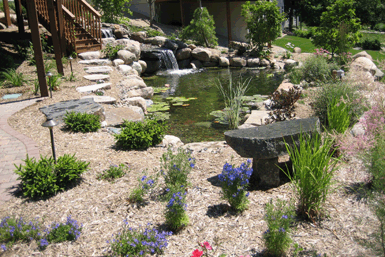Tier One Landscape wants to help you keep your landscape plantings healthy and vibrant. Tier One Landscape recommends that all landscape owners focus on watering, fertilizing, mulching, and fighting weeds. Many plants suffer from shock after being transplanted into a new environment. Don’t worry: even though some plants may wilt a bit and lose a few leaves, it’s a good thing. The plants are focusing their energies on regrowing root-hairs in order to adapt to their new surroundings. Keep your focus on water, fertilizer, mulch, and weeds, and let the plants do the rest.
Water is the most basic component of a healthy ecosystem. Many new landscape plants suffer from either too much or not enough water. You can figure it out by scraping mulch away from the base of the plant and feeling the soil with your fingers. If the soil around the root ball is dry, then the plant needs more water. If it’s soggy, then the plant needs less water. The ideal situation is for the soil around the plant rot ball to feel moist and rich. Check your soil before watering!
Plants thrive when given slow-release fertilizer in the springtime. Slow-release fertilizers work well because they release into the plant when moisture and heat conditions are ideal. When selecting a slow-release fertilizer, be sure to read and follow package instructions carefully. Too much fertilizer can burn your plants!
Mulch is a multi-purpose product. In addition to providing that finishing look for your landscape, mulch helps the soil around your landscape plants and trees retain water, maintain a constant temperature, and prevent weeds from finding a place to take root. We suggest adding a 3- to 4-inch layer of hardwood mulch to your landscape beds and paths. In addition, we prefer natural hardwood mulch: its natural appearance and long life makes it a smart investment. Steer clear of the dyed-red, faux cedar look!
While mulch can prevent some types of weeds, other weeds require a more rigorous attack. In addition to manually weeding your landscape, we recommend use of both pre- and post-emergent herbicides to control weeds. Pre-emergent herbicides stop weeds at the point of sprouting. Preen is a very effective and easy-to-locate pre-emergent herbicide that works well in landscape beds. In contrast to pre-emergent herbicides, post-emergent herbicides stop weeds after sprouting, when the weed is in full growth mode. Round-up is a tried-and-true weed control product; while highly effective, homeowners should take care with its use as it will kill any growing plant. Other generally-available products target specific types of weeds—such as broadleaf weeds—and may be used safely near plants you intend to keep. Finally, Tier One Landscape offers a variety of lawn care services and products; consult with your representative for details about fertilizer and herbicide packages.
Finally… a few product recommendations. Rootblast Once-A-Season Growth Formula works wonders for plant root development. We also love Spray-N-Grow Micronutrient for plants—amazing results with our annuals and perennials. And like many gardeners before us, we believe in Miracle-Gro.
Tier One Landscape hopes you find this information helpful. We do, however, recommend that you read all product instructions and consult with a water feature professional. Though Tier One Landscape provides this information for your use in good faith, this information is offered as-is, without warranty of any kind; please use at your own discretion. If you have any questions about these or other outdoor living, landscape design, and maintenance topics, please contact Tier One Landscape.
